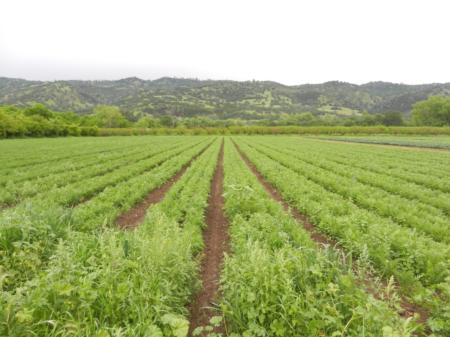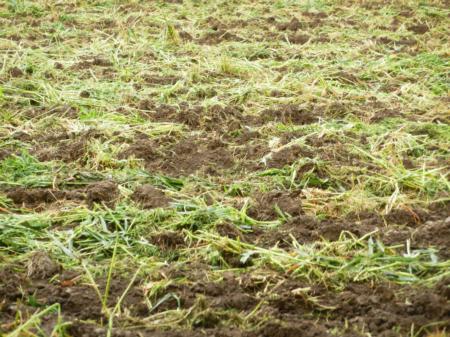Full Belly Farm - Diversified, Organic
Full Belly Farm is a diversified organic farm in the Capay Valley that produces over 80 different crops, from vegetables, fruits, and nuts to cut flowers, eggs and wool. The farm is owned by 4 partners, Andrew Brait, Judith Redmond, Paul Muller, and Dru Rivers and consists of 250 acres of owned land plus an additional 150 acres that are rented. It has been certified organic by CCOF since 1985, and sells to wholesale and retail stores and restaurants. Its products also reach consumers directly through multiple farmers markets and a 1,100-member Community Supported Agriculture project that delivers to customer pick-up locations throughout the San Francisco Bay and Sacramento areas.

The farm owners serve on the Boards of many community organizations and educational institutions, including the Ecological Farming Association, Community Alliance with Family Farmers, and the Agricultural Sustainability Institute at the University of California, Davis. Every year, Full Belly Farm hosts the Hoes Down Harvest Festival, a celebration that introduces the local community to agriculture through hands-on workshops, seminars, farm tours, musical performances, and farm-oriented children’s games and also raises funds for organizations that promote sustainable farming and living.
Cover crops and compost provide the foundation for nutrient management at Full Belly. As Paul Muller explains, “We’re harvesting energy from the sun. The more we can keep plants growing in the ground, the more energy we can harvest.” In keeping with this philosophy, all fields are cover cropped usually in the winter, sometimes in the summer, but at least once per year. The use of summer cover cropping has allowed Full Belly to cover crop their ground with greater frequency. Compost is also applied at every new planting of a crop. It is through these soil management practices that Full Belly creates nutrient rich soils and builds organic matter to support crop production.
Cover Cropping
For winter cover crops, they primarily use an oat and vetch mixture, but they often experiment with different mixes. For example, if they have wheat seed left over from planting a wheat crop, they will often add that to the cover crop mix. They may also include field peas. They avoid using fava beans as a winter cover crop because they tend to harbor aphids. They use a Sudan grass/cowpeas/buckwheat mix for a summer cover crop. Winter cover crops are usually planted from October through December, and Sudan grass is planted from May to August.
Springtime management of a winter cover crop involves mowing the cover crop, adding compost, then tilling the cover crop and compost into the soil together. Sheep also often play a central role as a tool in managing cover crops and soil fertility. They are often brought into a field to graze the cover crop prior to tilling. The sheep also graze on crop residues after harvest is completed.

The cover cropping practices and cultivation at Full Belly have evolved over the years. For example, the farmers maintain semi-permanent beds in some of their fields. The cover crops often grow so tall that they will fall into the furrows, with the potential to create slimy conditions if they are driven over in the process of mowing. To prevent this situation, the farmers have perfected a technique of cutting and flipping the cover crops out of the furrows with coulter disk followed by a shovel, which moves all the biomass to the top of the beds prior to tilling it in.
In order to improve soil structure and nutrient cycling, all Full Belly orchards maintain a permanent cover that is periodically replaced, i.e. every two to five years. The cover is composed of annual and perennial mixes of clovers, fescue, and medic.
Compost Application
Full Belly purchases all their compost, which is derived from urban green waste. The compost is applied with every new cropping of a field, generally in the range of 6 - 10 tons/acre over the season, depending on the year.
Sometimes the quality of the compost they purchase is not optimal, containing plastic waste, or materials that have not been fully composted yet, and is still hot when it arrives on the farm. They would like to make their own, higher-quality compost, but doing so would entail an entire additional operation to manage on the farm, and would require importing organic matter from off-farm.
When using compost in the spring, Paul Muller has found that a commercial microbial additive, such as Super Bio Soil Builder, can help to digest all the organic matter in the cover crop, in order to begin to release nutrients. The breakdown of organic matter is monitored and crop seeds are only planted once decomposition is complete. They check for decomposition in the planting zone, one to three inches deep. Clods of material on top of the soil are not of concern, since they won’t break down for a long time anyway.
Other practices
Although the cover cropping and compost go a long way towards creating the fertility in the soils at Full Belly, they do need to supplement with additional soil amendments. According to Judith Redmond, “We think that our cover crops and compost provide a lot of micronutrients. Because of high magnesium heavy clay soils, they amend with calcium sulfate (gypsum) because it really improves the soil tilth and pH balance. We sometimes side dress with a pelleted fertilizer when we think the crop may need it.” They will apply Gypsum for calcium in the amount of one to two tons per acre annually, and, if needed, about 1/5 ton/acre of pelleted fertilizer.
Full Belly has been experimenting with the alternative soil management approach of using a field as a sheep pasture for a few years, and then converting it to a crop field. By grazing a field, sheep enhance residue cycling and control weeds and other pests. Judith says, “We are still using sheep at Full Belly. We think they are an important part of the soil fertility picture. We follow the harvest intervals recommended by various [food safety] regulations, but hope that additional research will shed light on the best way to encourage an active soil microbial community.”
They are also experimenting with taking row crop ground out of production for two or three years at a time, with the idea of rebuilding soil structure. “We don't have much more than anecdotal evidence on the effectiveness of this in terms of fertility. Sometimes it seems like a good idea to break our row cropping cycle and stop tilling a field.”
Monitoring
Full Belly conducts soil tests periodically, with any given field being tested at least every few years. Tests are performed to monitor macro and micro nutrients as well as organic matter. They monitor soil test results over time, and have seen their soil organic matter trending toward 3% and over. Comparable Central Valley soils are usually 2% or less. They also obtain nutrient analyses for the compost that they purchase, and they purchase only compost certified by the Organic Materials Review Institute as being suitable for use in organic production. They use these tests to plan out their nutrient management for the season.
Challenges and Tradeoffs
Winter cover crops can present timing challenges, based on spring rainfall. In a wet spring with late rains, it can be difficult to get into the field to mow down and till the cover crop on time for planting the spring or summer crop. Full Belly can meet this challenge by staying flexible. For example, unlike some producers, Full Belly is not tied to contracts with processors that dictate crop planting and harvest dates. In the case of very early spring crops, such as early broccoli that is transplanted in February, they will also forego planting a winter cover crop on that field. However, it may receive a summer cover crop of Sudan grass, instead, after the broccoli crop is completed.
Although the use of sheep in the field presents many benefits, they must be monitored carefully, which can be a challenge. It is crucial to manage the timing of sheep in a field very carefully, based on weather conditions. In rainy weather, they can compact the soil in certain areas and damage the soil structure. The use of sheep is also increasingly limited by new food safety regulations that require longer intervals between the time that livestock are in a field and crop harvest. As a result, the farmers have had to curtail some of their use of sheep to eat down cover crops.
Full Belly still utilizes tillage (deeper) for soil preparation and tractor cultivation (more shallow) for weed control. The farmers are very interested in decreasing their tillage and growing cover crops for mulch, as they believe that this method can provide significant benefits in terms of conservation of soil moisture. However, going to a no-till system requires devising an entirely new residue, moisture and weed control strategy. To date, the farm has experimented with a cover crop chevron roller, no-till planters and custom residue management tools. A future no-till strategy might also include different cover crop species that are more easily managed by rolling or mowing.
Soil amendments at a glance
Summer Cover crops |
Seed Cost |
Seeding Rate |
| Sudan Grass | 96¢ /lb | 30 or 40 lbs/acre |
| Cow Pea | $1.45 /lb | 20 lb/acre |
| Buckwheat | 75¢ /lb | 10 lb/acre |
Winter Cover Crops |
Seed Cost |
Approx. Seeding Rate |
| Montezuma oats |
40¢/lb |
70-lbs/acre |
| Purple Vetch |
90¢/lb |
20-lbs/acre |
Compost Cost and application rates
|
|
Cost |
Application Rates |
| Compost |
$30/ton |
6-10 tons/acre |
Additional Fertilizers
Fertilizer |
Cost |
Application Rate |
| Gypsum | $60/ton | 1-2 tons/acre annually |
| Pelleted Fertilizer | $400/tom | $80-worth/acre |
Advice for other organic growers
Nutrient management in an organic system requires thinking ahead to maintain a consistent baseline of soil fertility over time, since most materials and techniques provide a slow release of nutrients rather than instant fixes. “In terms of nutrient availability it is important to understand that most of these materials are stable (insoluble) and become available over time. We think of nutrient management as baseline rather than immediate deficiency management,” said Andrew Brait.
